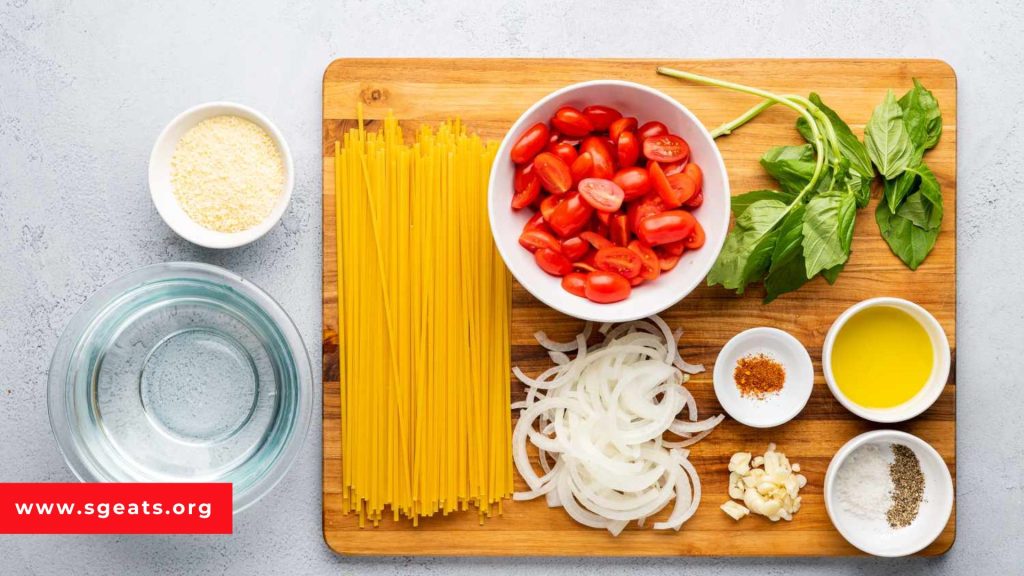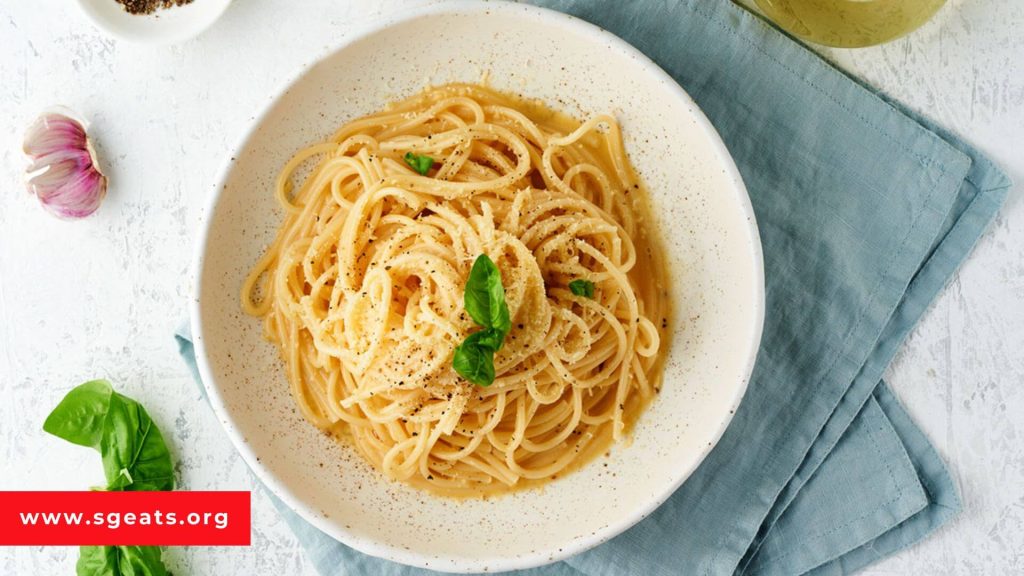Easy Spaghetti Aglio Olio
Imagine a dish that’s as easy to make as it is delicious: Aglio e Olio, an Italian classic sure to please even the pickiest eaters. So grab your garlic, olive oil, and a sprinkle of red pepper flakes for the Aglio Olio Recipe. Let’s embark on a journey to create the perfect Aglio e Olio. This step-by-step guide for Aglio Olio Recipe will walk you through creating the ideal Aglio Olio, ensuring a delightful culinary experience.
Aglio Olio Recipe Ingredients
- 5 cloves of garlic, thinly sliced
- Extra virgin olive oil or regular olive oil
- 2 servings of spaghetti
- 5-6 liters of water
- 2 tablespoons salt
- Chilli flakes (to taste)
- Freshly chopped parsley
- Salt (to taste)
- Freshly ground black pepper (to taste)
- Proteins like prawns (Optional)
- Squeeze of lemon (Optional)
- Grated parmesan (Optional)
Equipments Needed for Aglio Olio Recipe
- Large pot for boiling pasta
- Wide pan for sautéing
- Wooden spoon for stirring
- Kitchen knife for mincing garlic
Step-by-Step Instructions
All The Things You Needs

Boiling Pasta
Bring a large pot of salted water to a boil.
Cook the spaghetti according to package instructions until al dente.
Reserve a cup of pasta water before draining.
Prepping Ingredients
Finely mince the garlic and chop fresh parsley while the pasta cooks.
Cooking Garlic
Heat olive oil in a wide pan over medium heat.
Add minced garlic and sauté until fragrant, ensuring not to brown it.
Adding Red Pepper Flakes (Optional)
Add red pepper flakes to the pan and stir briefly for a subtle kick.
Infusing Flavors
Allow the garlic to infuse the olive oil with its rich flavour.
Maintain medium heat to prevent burning.
Cooking Pasta
Transfer the cooked pasta directly to the pan using tongs.
Toss the pasta in the infused oil, ensuring an even coating.
Finishing Touches
Season with salt and black pepper to taste.
Garnish with fresh parsley for a burst of colour and flavour.
Serving Suggestions
Sprinkle with grated Parmesan or Pecorino cheese.
Serve with a side of crusty bread for a complete meal.
Pair with light and crisp white wine like Pinot Grigio.

Tips and Tricks
Use high-quality, extra-virgin olive oil for the best flavour.
Adjust the red pepper flakes to your preferred level of spiciness.
Please don’t rush the garlic; allow it to slowly infuse the oil for maximum flavour.
Storing Aglio Olio
Refrigeration:
- Allow the Aglio Olio to cool to room temperature before refrigerating.
- Transfer the pasta to an airtight container or cover the pan with plastic wrap.
- Refrigerate for up to 2-3 days.
Freezing (for more extended storage):
- While Aglio Olio can be frozen, remember that the pasta’s texture may change slightly upon thawing.
- Place the cooled Aglio Olio in a freezer-safe container, removing as much air as possible.
- Freeze for up to 1-2 months.
Reheating Aglio Olio:
Refrigerated Leftovers:
Pan Reheating:
Heat a pan on low to medium heat.
Add a small amount of olive oil to prevent sticking.
Toss the refrigerated Aglio Olio in the pan until it’s evenly heated.
Add a splash of water or reserved pasta water if it seems dry.
Microwave:
Place a portion of the Aglio Olio in a microwave-safe dish.
Microwave in 30-second intervals, stirring in between, until it reaches your desired temperature.
Add a little water if needed to prevent drying.
Frozen Leftovers:
Thawing:
Transfer the frozen Aglio Olio to the refrigerator and let it thaw overnight.
Reheating:
Follow the same reheating methods mentioned for refrigerated leftovers.
Remember that frozen and thawed pasta might have a softer texture than freshly cooked.
Tips for Having Delicious Aglio Olio After Reheating
Fresh Ingredients: While reheating helps restore the flavours, the dish is always best when made fresh. Try to consume it as soon as possible.
Pasta Texture: Pasta tends to absorb liquids over time, so you might need to add olive oil or pasta water while reheating to restore the desired texture.
Avoid Overheating: To prevent the dish from becoming too dry or the garlic from becoming bitter, avoid overheating during the reheating process.
Following these guidelines, you can store and reheat your Aglio Olio with minimal impact on its delicious flavours and textures.
Conclusion
With its minimalistic yet robust flavours, Aglio Olio is a culinary masterpiece anyone can master. Whether you’re a beginner or an experienced cook, this Aglio Olio Recipe promises a satisfying and authentic taste of Italy. Gather your ingredients, follow the steps, and indulge in the magic of Aglio Olio. This timeless dish never fails to impress. Aglio Olio is best enjoyed fresh, but if you have leftovers or need to store them for later use, here’s a guide on how to store and reheat them.






